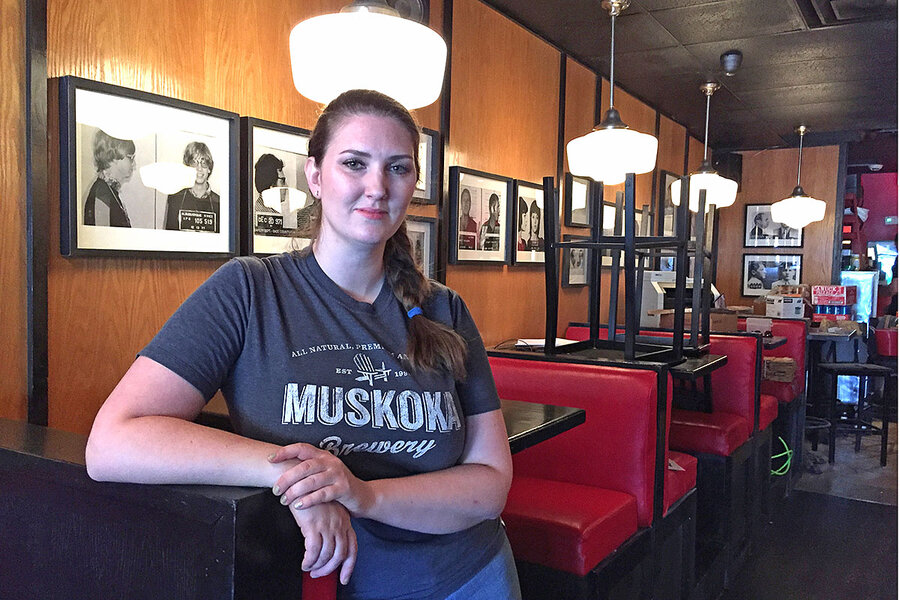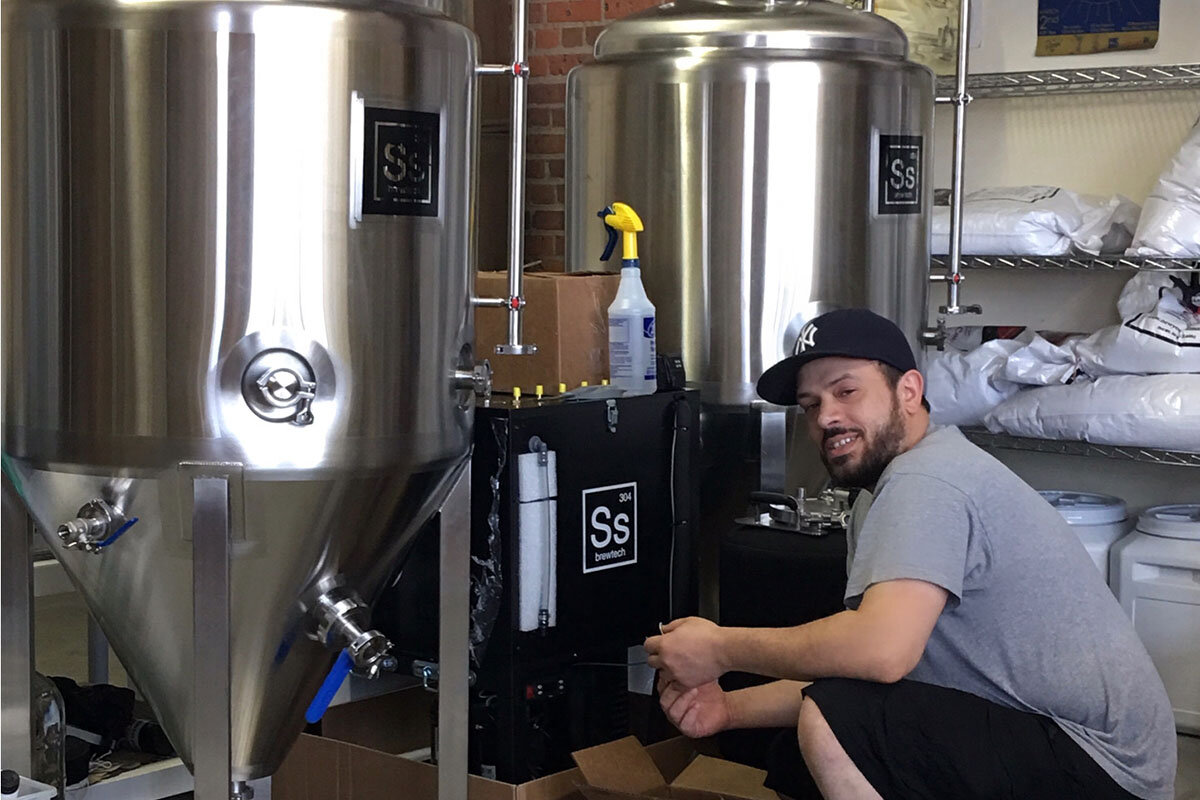In a pandemic, is a fast government check better than a larger one?
Loading...
| Toronto and New York
Sarah Brewer, general manager at The Mugshot Tavern in Canada’s largest metropolis, was laid off on March 16.
In America’s biggest city, Oscar Santiago was also laid off in mid-March, from his job at the Gun Hill Brewing Co. in the Bronx, in the days after global health officials declared a pandemic that caused a cascade of shutdowns worldwide.
For Ms. Brewer, being fired was followed by a fraught two weeks. “I was having really bad anxiety; I had to jump into home schooling with no income and no idea of what the future would bring,” she says. But by the end of March, Canadian Prime Minister Justin Trudeau announced the Canada Emergency Response Benefit (CERB) for Canadians who lost jobs, got sick, had to quarantine, or had care for children out of school. At $2,000 (Canadian; U.S.$1,470) per four-week period, it meets her former salary minus tips, or about 70% of what she used to earn.
Why We Wrote This
The pandemic has forced governments to come to their citizens’ aid during business shutdowns – and just how they’ve done it is illuminating values. In Part 1 of “One pandemic, many safety nets: A global series,” we compare the responses of the United States and Canada.
Mr. Santiago went through a difficult two months before he saw any government money. “There’s an obvious sense of hopelessness. You don’t know what’s coming,” he says. Once the payments began, thanks to a temporary $600 per week in extra jobless benefits, he has ended up making more money off the job than he did on – a show of how the world’s largest economy can support vulnerable people when it wants. Still Mr. Santiago, like many Americans, knows this bonus will be short-lived, so he is driving less, eating in, and using grocery coupons in anticipation of navigating future uncertainty.
Editor’s note: As a public service, all our coronavirus coverage is free. No paywall.
Safety nets around the world are bearing untold weight. And from North America to Europe, Asia to Latin America, countries are taking distinct approaches to blunt the economic, social, and political consequences. Those programs tend to reflect a country’s values and ethos around work and welfare, as the experiences of Ms. Brewer and Mr. Santiago show.
“There is a difference philosophically between the two safety nets. The U.S. one tends to be very flimsy in general. It is ramped up usually during the crisis like we had with the Great Recession, and nowadays with the pandemic. But generally it tends to be stingier and less supportive, especially of those who don’t work,” says Victor Chen, assistant professor of sociology at Virginia Commonwealth University, who studies economic inequality and compared autoworkers in Canada and the United States in his book “Cut Loose: Jobless and Hopeless in an Unfair Economy.”
And so even if Ms. Brewer is pocketing less money now and Mr. Santiago more, Ms. Brewer feels on firmer footing. “In terms of feeling safe, I’m super glad we are in Canada.”
“The difference actually isn’t monetary”
Canada’s introduction of the CERB was lauded for how quickly the country replaced its system for paying jobless benefits with a simpler payout across the board of C$500 per week for four months. (It was recently extended for two additional months and will end in early October.) It has faced various criticisms, including that it would discourage workers from returning to jobs, but the pushback was much weaker than against equivalent policies in the U.S. “I suspect the difference actually isn’t monetary. It’s speed,” says David Macdonald, senior economist at the Canadian Centre for Policy Alternatives in Ottawa. “It’s the speed with which you can get your application and get your money in your bank account and pay your rent.”
More than 40 million Americans have filed for unemployment insurance benefits since the pandemic started, leaving the U.S. unemployment rate higher than at any time since the Great Depression. Applicants faced a patchwork of assistance that varies widely by state. Congress passed temporary federal pandemic legislation – the Coronavirus Aid, Relief, and Economic Security (CARES) Act – in March that gives unemployed workers an extra $600 per week through July.
Since the state of New York offers one of the more substantial unemployment benefits, with average payouts running up to $504 every week for up to 26 weeks, Mr. Santiago takes in more today with the supplement than he was – $780 a week now (after taxes) compared with netting $600 pre-pandemic. But workers in North Carolina and Missouri would each tap out at fewer than 14 weeks’ coverage, were it not for the temporary CARES Act provisions that may extend the duration of benefits to up to 39 weeks in 2020. And the size of weekly payments also varies. With the booster from the CARES Act set to expire soon unless Congress takes fresh action, maximum weekly benefits will range from $235 in Mississippi to almost four times that in Massachusetts, according to Saving to Invest, a personal finance blog.
In a first, Congress has also provided assistance to contractors, gig workers, and the self-employed: those who have long fallen through the cracks of the 21st-century economy, says Stephen Wandner, a senior fellow at the National Academy of Social Insurance. But he says these moves will be insufficient once the $600 top-up ends. “If Congress doesn’t act, some people will be hungry and eventually homeless,” he says.
Mr. Santiago says he doesn’t know how he’ll pay his bills come August. Without the supplement, Mr. Santiago will have to make do with $257 a month after taxes – that’s less than half his paycheck at the brewery. Rent alone runs more than $800 each month in Queens, where he lives with his girlfriend. “It’s been super tough, but at least I’m not alone in my suffering,” he says.
Ms. Brewer’s life is stressful, too. Her husband owns The Mugshot Tavern and has worked every day trying to keep the business running on takeout orders. They just opened partial service on their patio under local laws. They had invested in another restaurant a year ago whose doors remain shuttered since the shutdowns were first ordered and are now trying to build a patio in the back parking lot. And the future of hospitality worldwide is a vast unknown with strict social distancing rules required.
“Restaurants and most businesses are not made to operate at half-capacity,” she says. “We don’t know how that will affect hours and wages.”
But even before CERB, Canada’s system was much more robust than that in the U.S., especially for precarious families like single-earner households, and it includes universal health care. “If a worker in Canada loses a job [the worker] does not lose health care. That’s a huge single thing,” says Richard Johnston, a professor of comparative politics at the University of British Columbia in Vancouver. “So you don’t have a whole other set of cascading catastrophes that just simply fall from losing a job.”
“It is a huge peace of mind,” says Ms. Brewer. “I don’t have to worry about paying if my son falls out of a tree.”
“We’re not like Sweden”
In the U.S., benefits have temporarily expanded amid the pandemic, but they’ve been on a downward trajectory since the 1980s – being paid to fewer people in smaller amounts for shorter periods. A recent paper from Johns Hopkins University in Baltimore says only about one-third of America’s unemployed receive unemployment insurance payments. Many states either don’t want to pay benefits or can’t afford to. There’s little nationwide outcry for change. Some connect that to racism.
“There’s a radicalized perspective that Social Security is good because old white people are using it, but Medicaid is bad because younger, minority people are using it,” says Chris Jackson, a senior vice president and lead for the American public polling practice at Ipsos, a global market research company. “We’ve gotten here because we want to be here. It’s not that people want to have a bad social safety net. People saying, ‘I can look after myself, and other people can take a hike,’ over the course of 50 years is what has led us to this point.”
While some Americans may think Europe’s generous welfare benefits could stifle individual responsibilities, Canada offers something of a middle way in its balance to rev the economic engine but secure workers. “It’s not like Canada is a social democratic society. We’re not like Sweden. ... We do not spend the kind of money, nor do we offer [policies] in a universal way remotely to the extent that a Scandinavian country does, or even like lots of not-so-universalistic countries like Germany,” says Dr. Johnston. “But we do deliver cash in ways that are quite powerfully redistributive. So the ability of taxes and transfers, for example, to offset market income inequalities in Canada is quite a bit more robust than in the U.S. ... It’s just less ragged here.”
Ms. Brewer and Mr. Santiago are both eager to get back to full-time employment. But one might have an easier path forward, says Dr. Chen.
American workers “are going to see more stigma. ... The kind of self-blame on the U.S. side, and the blame [toward] people who are unemployed, it tends to be quite intense,” he says. “I would be more secure in Canada because of that past history of support. There is more of a sense of a longer-term commitment to making sure folks ride out the storm. In America, our generosity is very short-lived.”
Editor’s note: As a public service, all our coronavirus coverage is free. No paywall.







